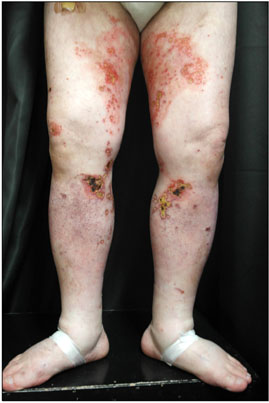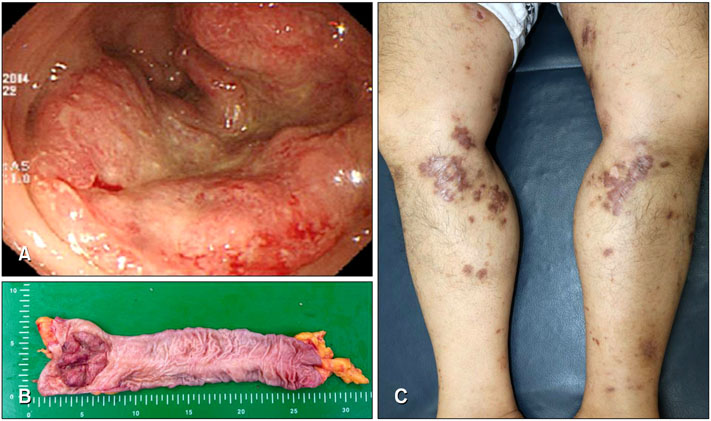Ann Dermatol.
2018 Feb;30(1):79-82. 10.5021/ad.2018.30.1.79.
Paraneoplastic Pyoderma Gangrenosum Associated with Rectal Adenocarcinoma
- Affiliations
-
- 1Department of Dermatology, Chonnam National University Medical School, Gwangju, Korea. schul@chonnam.ac.kr
- 2Department of Surgery, Chonnam National University Medical School, Gwangju, Korea.
- KMID: 2399759
- DOI: http://doi.org/10.5021/ad.2018.30.1.79
Abstract
- Pyoderma gangrenosum (PG) is a rare chronic neutrophilic dermatosis characterized by painful necrotic ulceration. The most common diseases associated with PG are inflammatory bowel disease, certain rheumatologic and hematologic diseases, and malignancy. Here, we describe the case of a 60-year-old man who presented with pruritic and painful erythematous ulcerative macules and patches on both lower extremities, and was diagnosed with PG based on his clinical and histologic features. His PG became exacerbated despite standard therapy with a high-dose systemic steroid in combination with dapsone and cyclosporine. Systemic evaluation of underlying conditions revealed rectal adenocarcinoma at the rectosigmoid junction (T3N0M0), which was completely removed via Hartmann's procedure followed by adjuvant chemotherapy. Two months after anticancer therapy, his PG was completely healed with hypertrophic scarring. Herein, we present the first case of paraneoplastic PG caused by rectal adenocarcinoma in Korea.
MeSH Terms
Figure
Reference
-
1. Crowson AN, Mihm MC Jr, Magro C. Pyoderma gangrenosum: a review. J Cutan Pathol. 2003; 30:97–107.
Article2. Magro CM, Crowson AN. A distinctive vesiculopustular eruption associated with hepatobiliary disease. Int J Dermatol. 1997; 36:837–844.
Article3. Lee JI, Park HJ, Lee JY, Cho BK. A case of pyoderma gangrenosum with ulcerative colitis treated with mesalazine. Ann Dermatol. 2010; 22:422–425.
Article4. Duguid CM, O'Loughlin S, Otridge B, Powell FC. Paraneoplastic pyoderma gangrenosum. Australas J Dermatol. 1993; 34:17–22.
Article5. Su WP, Davis MD, Weenig RH, Powell FC, Perry HO. Pyoderma gangrenosum: clinicopathologic correlation and proposed diagnostic criteria. Int J Dermatol. 2004; 43:790–800.
Article6. Powell FC, Su WP, Perry HO. Pyoderma gangrenosum: classification and management. J Am Acad Dermatol. 1996; 34:395–409.
Article7. Mlika RB, Riahi I, Fenniche S, Mokni M, Dhaoui MR, Dess N, et al. Pyoderma gangrenosum: a report of 21 cases. Int J Dermatol. 2002; 41:65–68.
Article8. Gateley CA, Foster ME. Pyoderma gangrenosum of the breast. Br J Clin Pract. 1990; 44:713–714.9. Gallo R, Parodi A, Rebora A. Pyoderma gangrenosum in a patient with gastric carcinoma. Int J Dermatol. 1995; 34:713–714.
Article10. Basille W, Dompmartin A, Lorier E, Sautreuil B, Girardot PM, Leroy D. Pyoderma gangrenosum. Association to acinar cell carcinoma of the parotid gland. Ann Dermatol Venereol. 1992; 119:381–383.11. Bunte C, Popp-Habeler J, Mischer P, Tuppy H, Haidenthaler A, Knoflach P, et al. Concomitant manifestation of pyoderma gangrenosum and colorectal carcinoma. Scand J Gastroenterol. 2008; 43:756–758.
Article12. Regnier-Rosencher E, Bizet N, Méry L. Pyoderma gangrenosum associated with renal carcinoma. J Am Acad Dermatol. 2011; 64:1208–1211.
Article13. Foley CC, Laing M. Paraneoplastic pyoderma gangrenosum successfully treated with minocycline and low-dose steroids. J Eur Acad Dermatol Venereol. 2015; 29:184–185.
Article14. Sakai H, Otsubo S, Iizuka H. Peristomal pyoderma gangrenosum associated with rectal adenocarcinoma. J Dermatol. 2006; 33:68–70.
Article15. Shahi V, Wetter DA. Pyoderma gangrenosum associated with solid organ malignancies. Int J Dermatol. 2015; 54:e351–e357.
Article16. Adachi Y, Kindzelskii AL, Cookingham G, Shaya S, Moore EC, Todd RF 3rd, et al. Aberrant neutrophil trafficking and metabolic oscillations in severe pyoderma gangrenosum. J Invest Dermatol. 1998; 111:259–268.
Article
- Full Text Links
- Actions
-
Cited
- CITED
-
- Close
- Share
- Similar articles
-
- A Case of Behcet's Disease Associated with Pyoderma Gangrenosum
- A Case of Pyoderma Gangrenosum Occurring in Behcet's Disease
- A Case of Pyoderma Gangrenosum with Rectal Polyp
- A Case of Pyoderma Gangrenosum Associated with Acute Leukemia
- A Case of Post-traumatic Pyoderma Gangrenosum Associated with Ulcerative Colitis



